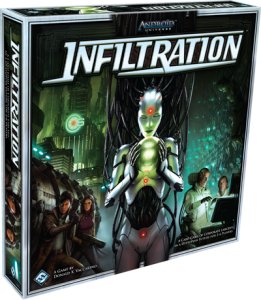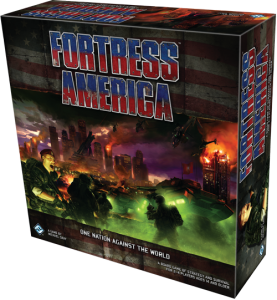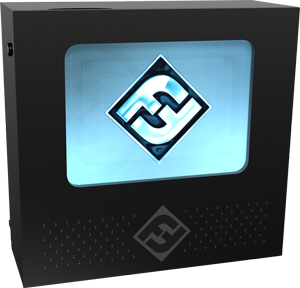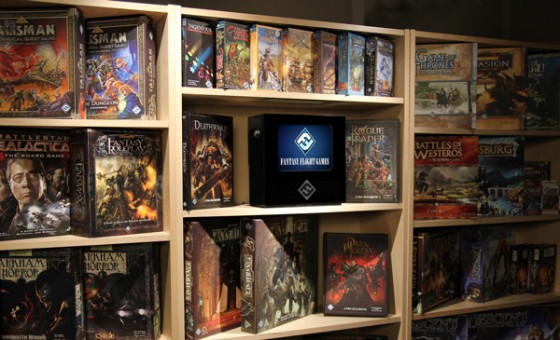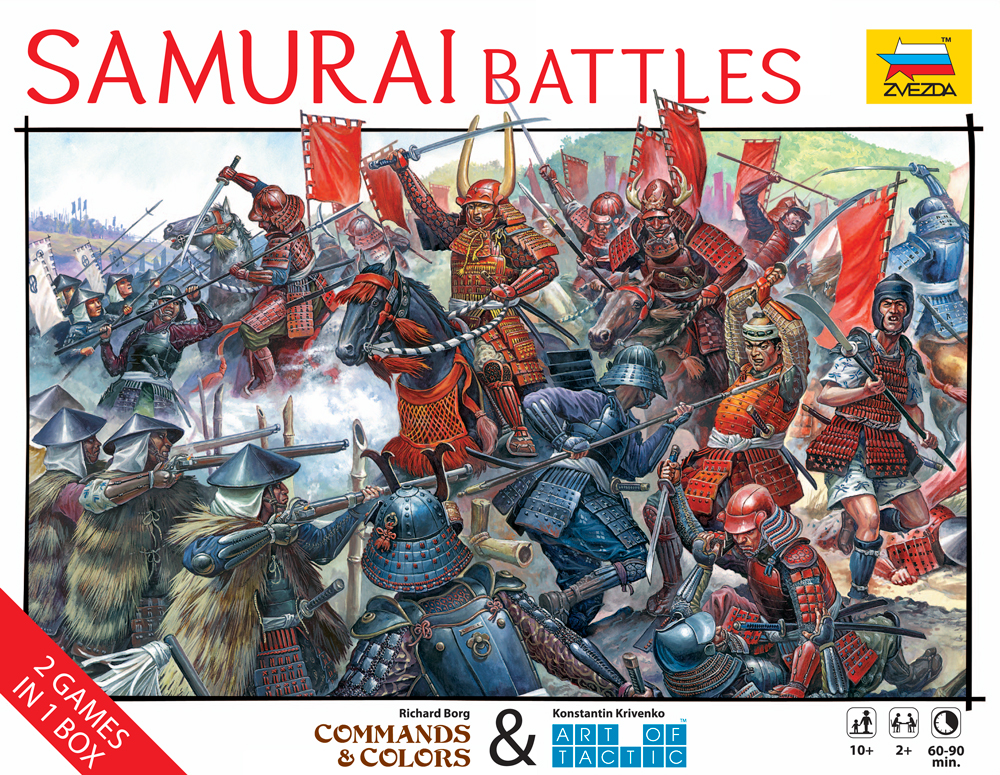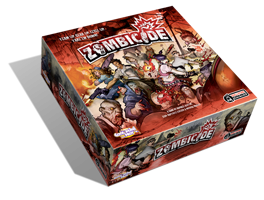Fantasy Flight Games: Retail Support and FFG Media Centers at the GTS
I know Fantasy Flight Games primarily as the licensee of many different Games Workshop intellectual properties (Horus Heresy, Dark Heresy, Warhammer Fantasy Role Play), as well as the distributor of Dust Tactics and Tannhauser. Of course, they have dozens and dozens of other highly successful games too. I managed to catch 2 of their 4 seminars at the 2012 GAMA Trade Show.
Fantasy Flight Games Retail Support
Steve Horvath, VP of Marketing for Fantasy Flight Games covered a number of FFG product releases including Donald Vaccarino’s newest game Infiltration, as well as their upcoming FFG release of the popular Fortress America, previously put out by Milton Bradley. A variant of the game in the early 1990s when I played it was to combine the futuristic playing pieces from Fortress America with the Axis and Allies playing board to have a futuristic global battle. The second edition of the wildly popular Descent was also covered, which may be one of their most expensive games that Fantasy Flight has produced yet.
At Fantasy Flight Games’s headquarters in a suburb of Minneapolis, they have created a storefront in their warehouse, which they use for playtesting. The Fantasy Flight Games Event Center is also used by the company’s 92 employees to relax, play games in, and have their lunches there. Horvath said that it’s both “an exciting place” and has also been a “sobering experience”. Besides employee use, Fantasy Flight cultivates playtesters there and experiments in ways to help the retail community in general. Obviously this is where they can test out the Fantasy Flight Games Media Centers as detailed below.
Horvath moved onto Organized Play (OP) and covered their game night kits which usually support 8 players. A larger kit which costs $150 is good for up to 16 players. Horvath stressed that Fantasy Flight actively supports preview nights, launch, and pre-launch parties and sells retailers demo copies for 75% off. The new Star Wars X-Wing game which I briefly saw demoed on Wednesday night at the show will be supported with OP. He also covered their support of their Living Card Games (LCGs). One such LCG that Fantasy Flight is very proud of is the Game of Thrones Living Card Game which celebrates its 10th anniversary. With the start of the second season of the HBO series based on George R.R. Martin’s epic fantasy series on April 1, FFG’s sales will dovetail nicely. But a popular tie-in cable series isn’t the LCG’s only draw, Horvath said “we also believe we have a hell of a game.”
The Fantasy Flight Games Media Center
The Media Center was actually the subject of a separate seminar by Fantasy Flight at the GAMA Trade Show. As of the 2012 GAMA Trade Show, over 250 retailers had signed up for Fantasy Flight’s program to have the Media Center in their stores. The Media Center is built around an Apple iPad in the chasis and measures 11.5 inches wide, 11 inches high, and is 4 inches deep. The Media Center uses the iPad’s WiFi connection to check for updates from Fantasy Flight Games every hour with new content available for it every week and also requires access to a wall outlet for power.
Bryan Bornmueller, Fantasy Flight’s Broad Market Sales Manager, led the seminar and explained that if retailers have an issue with a particular video being shown in the Media Center’s playlist, that they can contact FFG to have it removed. He cited a Chaos in the Old World video which raised concerns by a retailer in the Bible Belt; Fantasy Flight connected to the Media Center and pulled that content. Another possibility for retailers is submitting their own content to be played over the Media Center, such as an upcoming in-store tournament or release party announcement.
The benefit for retailers is an 30% average increase in Fantasy Flight Games product sales according to Bornmueller. The handout FFG distributed at the GTS had even higher numbers, stating an average of 35% with even as much as 70% sales increases. Part of those sales increases is an increased knowledge on the part of store employees about Fantasy Flight’s products. Store owners and employees are constantly bombarded by its promotional videos. There were questions from attending retailers about adjusting its volume (which is found at the top of the Media Center) with some retailers pointing out that they tune it out, but notice when a new video has been uploaded. A store owner brought up that most of his customers didn’t know that it was a tactile device, that customers can come up and interact with it and select to learn more about a particular game. This was also news to me. In Las Vegas, Little Shop of Magic has a Media Center and I went up to it after the GTS and “interacted” with it, hoping to get more information on Dust Warfare. Another retailer questioned whether it has close captioning, which the Media Center does not.
Another benefit for retailers is that stores that have a Media Center can receive extra support from Fantasy Flight Games. Applications were available for retailers who want to sign up for the program. The process is application, approval, and ordering $1000.00 or more of FFG product at the retailers’ cost. That actually only amounts to 20 of FFG’s big coffin games or 32 copies of Arkham Horror. Fantasy Flight can work with a retailer to tailor a bundle to their needs. The application is 3 pages of survey questions about the retailer and how they are selling FFG’s products followed by 2 pages of legalese, the actual placement contract, all of which is available on the Fantasy Flight Media Center website, ffmediacenter.com.
Further Thoughts on the Fantasy Flight Games Media Center
I do not run a gaming store, but if I did, would I want a Fantasy Flight Games Media Center? Yes, I think I would. While one retailer I spoke to has a an FFG Media Center and was skeptical of its 30+% increase in sales of their product, the numbers are strong enough to speak for themselves. While $1000.00 product commitment sounds like a lot to a game consumer, I don’t think I’m stretching it to say that a good retailer should easily be carrying and moving that amount of product.
I thought it would have been interesting at the seminar if, when Fantasy Flight asked who was using the Media Centers already, several retailers held theirs up instead of their hands and puzzled FFG by using them as their own personal iPads and playing Plants vs. Zombies on them and watching movies. A key point is that the Media Center belongs to Fantasy Flight Games. The company controls the Media Center, not the retailer. No one raised the question of retailers hacking into their Media Center to change its settings, which would definitely violate the Terms of Device Loan clause in the contract:
e.) That the device will exclusively be used for the purpose of displaying the “Fantasy Flight Channel” information and interactive content. At no time should the device be used for any other purpose, unless explicitly directed or agreed by FFG in writing.
Of course, what is unrealistic about my little fantasy scenario is that sensible business-driven store owners would want the Media Center in their stores during the GAMA Trade Show driving sales and not just have the Media Center as a plaything.
More importantly though, Fantasy Flight Games has spearheaded a drive to innovate game retailing. Even though I don’t own a gaming store, the possibilities suggested by the FF Media Center’s success are quite intriguing. Some retailers already use their own store monitors to advertise new comics and games, upcoming store events, and sales, but the manufacturer making the high quality videos frees them to running their stores and not micro-managing in-store advertising. What will store owners do when they have a similar product in the store from another game manufacturer? In larger stores, there would not be much competition in terms of noise volume, but in a small environment rival media devices could clash with one another. Even the numbers of Media Centers out in the wild in retail stores are interesting. 250 stores is only a tenth (at least) of the possible market of game stores that could have a Media Center.
Jon Huston of Troll and Toad also was intrigued by the device, stopping his Online Retailing seminar debate with Dave Wallace, to ask the audience for a show of hands on who was using the Media Center in their stores and whether they thought it had increased their sales. Huston pointed to the FFG Media Center as a prime example of how game manufacturers could help retailers and cited its low cost and small footprint as advantages to retailers.
